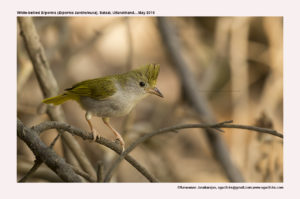
White-bellied Erpornis Erpornis zantholeuca
Etymology:
- Erpornis : Greek word herpo – to creep about ; ornis- bird
- Zantholeuca : Greek word xanthos – yellow; leukos – white
Vernacular names: Lepcha: Dung-pu-pho
Distribution in India: Resident of Himalayas and North East India.
Description: Size 11–13 cm; 8–17 g. It is small passerine resembling a Yuhina. It is yellowish-green above and greyish-white with yellow vent below, with short crest, squared-off tail, and mostly pale, sharp, slender bill with tip slightly bent over, and rather short and dainty legs. The nominate race has crown with slightly elongated feathers, upperparts and tail as yellowish-green, upperwing is fringed yellowish-green; lores are greyish-green, this colour extending vaguely over eye. The cheek and ear-coverts are pale silvery grey; underside is greyish-white, whitest on central area from chin to belly, vent is pale yellow. The iris is grey, chestnut, ruby-red or dark brown; bill is pinkish, culmen is brown; legs are greyish-rosy to whitish-flesh. Both the sexes are similar. The juvenile is duller than adult, upperparts and secondaries are with a brownish cast.
Habitat: It is found in broadleaf evergreen forest, secondary growth, selectively logged forest, light deciduous forest, mixed broadleaf-pine forest, moss forest and bamboo thickets. It is found from 200m up to 2300 m.
Food habits: It eats small grasshoppers and bush-crickets, and other insects and their larvae, berries, soft figs, flower nectar and seeds. It is less gregarious than other Yuhina. It is found singly all year, but also in pairs or small parties, and often in company with mixed flocks of warblers and other small babblers. It frequents lower canopy and higher bushes, in middle storey. It often hangs upside-down.
Breeding habits: They breed in Mar–Jun in Indian Subcontinent and Jan–Aug in South-East Asia. The nest is built by both sexes. The nest is a small, deep cradle made of fine grass stems, moss, rootlets, small dry leaves, finely shredded brown or other fibers, sometimes plentifully compacted with cobweb, lined with fine dark leaf stems, fine grasses and whitish fibers, suspended above ground between horizontal twigs of tree, bamboo or shrub. They lay a clutch of 2–3 eggs. The incubation is done by both sexes. The incubation period is for 13–14 days. The young are provisioned by both sexes.